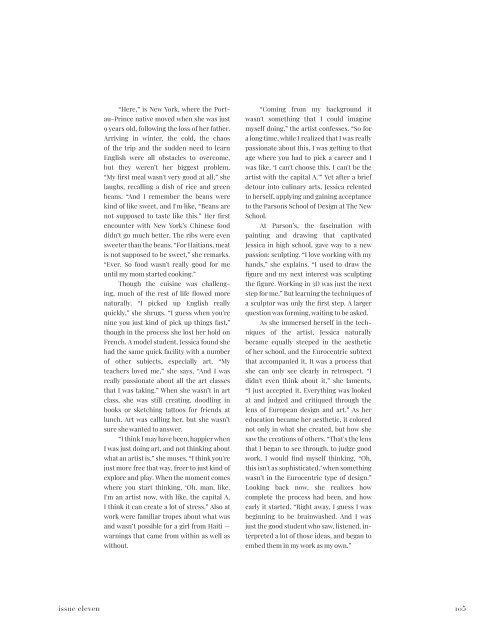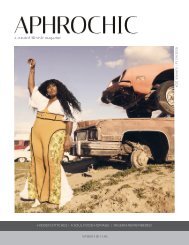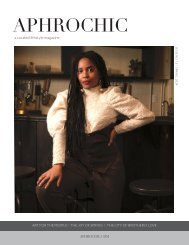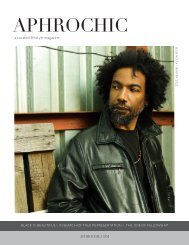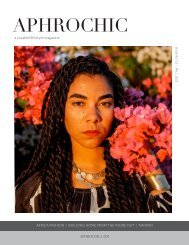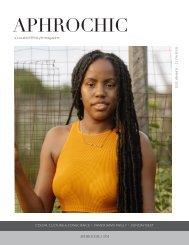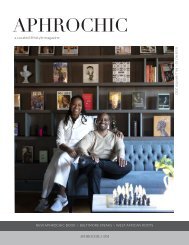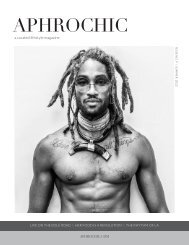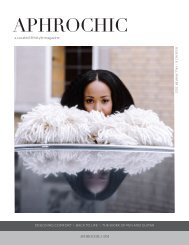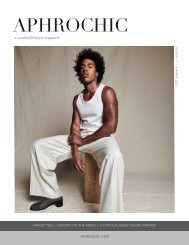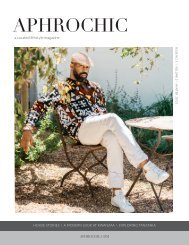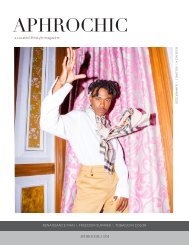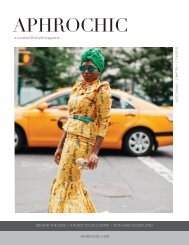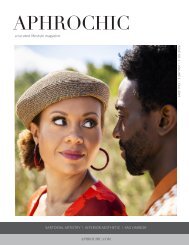AphroChic Magazine: Issue No. 11
Create successful ePaper yourself
Turn your PDF publications into a flip-book with our unique Google optimized e-Paper software.
“Here,” is New York, where the Portau-Prince<br />
native moved when she was just<br />
9 years old, following the loss of her father.<br />
Arriving in winter, the cold, the chaos<br />
of the trip and the sudden need to learn<br />
English were all obstacles to overcome,<br />
but they weren’t her biggest problem.<br />
“My first meal wasn't very good at all,” she<br />
laughs, recalling a dish of rice and green<br />
beans. “And I remember the beans were<br />
kind of like sweet, and I'm like, “Beans are<br />
not supposed to taste like this.” Her first<br />
encounter with New York’s Chinese food<br />
didn’t go much better. The ribs were even<br />
sweeter than the beans. “For Haitians, meat<br />
is not supposed to be sweet,” she remarks.<br />
“Ever. So food wasn't really good for me<br />
until my mom started cooking.”<br />
Though the cuisine was challenging,<br />
much of the rest of life flowed more<br />
naturally. “I picked up English really<br />
quickly,” she shrugs. “I guess when you're<br />
nine you just kind of pick up things fast,”<br />
though in the process she lost her hold on<br />
French. A model student, Jessica found she<br />
had the same quick facility with a number<br />
of other subjects, especially art. “My<br />
teachers loved me,” she says, “And I was<br />
really passionate about all the art classes<br />
that I was taking.” When she wasn’t in art<br />
class, she was still creating, doodling in<br />
books or sketching tattoos for friends at<br />
lunch. Art was calling her, but she wasn’t<br />
sure she wanted to answer.<br />
“I think I may have been, happier when<br />
I was just doing art, and not thinking about<br />
what an artist is,” she muses. “I think you're<br />
just more free that way, freer to just kind of<br />
explore and play. When the moment comes<br />
where you start thinking, ‘Oh, man, like,<br />
I'm an artist now, with like, the capital A,<br />
I think it can create a lot of stress.” Also at<br />
work were familiar tropes about what was<br />
and wasn’t possible for a girl from Haiti —<br />
warnings that came from within as well as<br />
without.<br />
“Coming from my background it<br />
wasn't something that I could imagine<br />
myself doing,” the artist confesses. “So for<br />
a long time, while I realized that I was really<br />
passionate about this, I was getting to that<br />
age where you had to pick a career and I<br />
was like, ‘I can't choose this. I can't be the<br />
artist with the capital A.’” Yet after a brief<br />
detour into culinary arts, Jessica relented<br />
to herself, applying and gaining acceptance<br />
to the Parsons School of Design at The New<br />
School.<br />
At Parson’s, the fascination with<br />
painting and drawing that captivated<br />
Jessica in high school, gave way to a new<br />
passion: sculpting. “I love working with my<br />
hands,” she explains. “I used to draw the<br />
figure and my next interest was sculpting<br />
the figure. Working in 3D was just the next<br />
step for me.” But learning the techniques of<br />
a sculptor was only the first step. A larger<br />
question was forming, waiting to be asked.<br />
As she immersed herself in the techniques<br />
of the artist, Jessica naturally<br />
became equally steeped in the aesthetic<br />
of her school, and the Eurocentric subtext<br />
that accompanied it. It was a process that<br />
she can only see clearly in retrospect. “I<br />
didn't even think about it,” she laments.<br />
“I just accepted it. Everything was looked<br />
at and judged and critiqued through the<br />
lens of European design and art.” As her<br />
education became her aesthetic, it colored<br />
not only in what she created, but how she<br />
saw the creations of others. “That's the lens<br />
that I began to see through, to judge good<br />
work. I would find myself thinking, “Oh,<br />
this isn't as sophisticated,’ when something<br />
wasn’t in the Eurocentric type of design.”<br />
Looking back now, she realizes how<br />
complete the process had been, and how<br />
early it started. “Right away, I guess I was<br />
beginning to be brainwashed. And I was<br />
just the good student who saw, listened, interpreted<br />
a lot of those ideas, and began to<br />
embed them in my work as my own.”<br />
issue eleven 105


